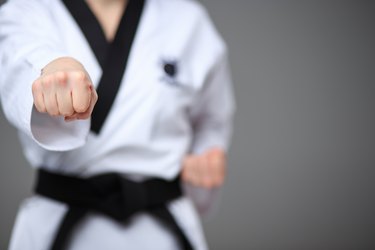
Do you want to learn martial arts but you either don't have time, can't afford it or you don't live close to a gym? Fear not, you can still train! First and foremost, you have to establish what style of martial arts you want to learn and what the purpose of your training is.
Usually, with martial arts training, people tend to seek one of four things (or a combination of some or all of them): self defense, getting into shape, learning how to fight/compete and mindfulness. Let's go over all of them.
Video of the Day
Video of the Day
1. Mindfulness
If mindfulness is you main goal, there are several traditional martial arts that can be practiced alone, such as Tai Chi, Karate and Kung Fu. You can learn forms and katas and practice alone.
2. Getting Into Shape
To get into good shape, there's a myriad of training regiments one can do. If you have a garage where you can hang a heavy bag, you can get a really good kickboxing workout.
With today's apps and websites, you can even have your own personal coach tell you what combinations to throw. If you have access to a soft floor, you can even work in some MMA drills, with sprawls, takedowns and ground skills.
3. Fighting/Competing
If your goal is to compete or fight, the truth is that you're going to need a coach. You're also going to need training partners, in order to spar. One training/sparring partner will suffice but the more the better in order to learn how to deal with different sizes and fighting styles.
4. Self-Defense
Just as with fighting, you're going to need someone to attack you. In fact, if you want any type of realistic fighting or self defense training, you'll need someone to train with, in order to get the realistic feel of a dynamic opponent. Another great thing about having a training partner is that you can do partner drills and work pads as well.
Read more: The 8 Best Cardio Kickboxing Moves
Practicing at Home
Areas you can focus on with your home training is strength, agility, flexibility and stamina. You can also drill combinations, which will make you fluid in your motions. As Bruce Lee said, "I fear not the man who has practiced 10,000 kicks once, but I fear the man who has practiced one kick 10,000 times."
With today's home gym equipment, YouTube videos and online services like YourKravMaga.com, you can actually get really good training in! Though most of the training drills require a partner, you don't necessarily need a full gym.
Although you can learn a lot of training from just watching YouTube, nothing replaces having an actual coach, who can give you constant feedback and make sure small details are executed correctly. Combining training at an actual martial art gym and at home is the best solution, but any training is better than no training. And in today's world with apps and websites, you can find high-level coaching pretty much anywhere!
Tips for Home Practice
- Always warm up for at least five minutes. This will reduce injury and allow you to exert greater range of motion as you progress. Warm up your arms so that punching doesn't pull your rotator cuff or strain your elbow. Stretch your legs so that learning kicks doesn't pull your hamstrings or strain your groin adductor muscles. Use twisting stretches for your core so that working out doesn't strain your lower back.
- Adopt a daily workout regimen that targets your cardiovascular system and the major muscle groups of the legs, core and upper body. For example, jog on Monday, do push-ups, squats and leg lifts on Tuesday. Jump rope on Wednesday and lift weights on Thursday. Rotate between cardiovascular and strength training from day to day and vary the specific exercises from one session to the next.
- Your stance as a martial artist determines the adequacy of your defense as well as the effectiveness of your strikes. Never face an attacker or an opponent square-on. Doing so provides them with the largest target your body can be. Turn your body to the side to make it a smaller target. If you are right-handed, your main fighting stance will be with your right leg back. Feet should be a shoulder-width-and-a-half apart. You knees should always be bent and weight shifted forward onto your toes.
- Identify a style of martial arts that works for you, and then find a good YouTube channel or online service. Some ideas include: